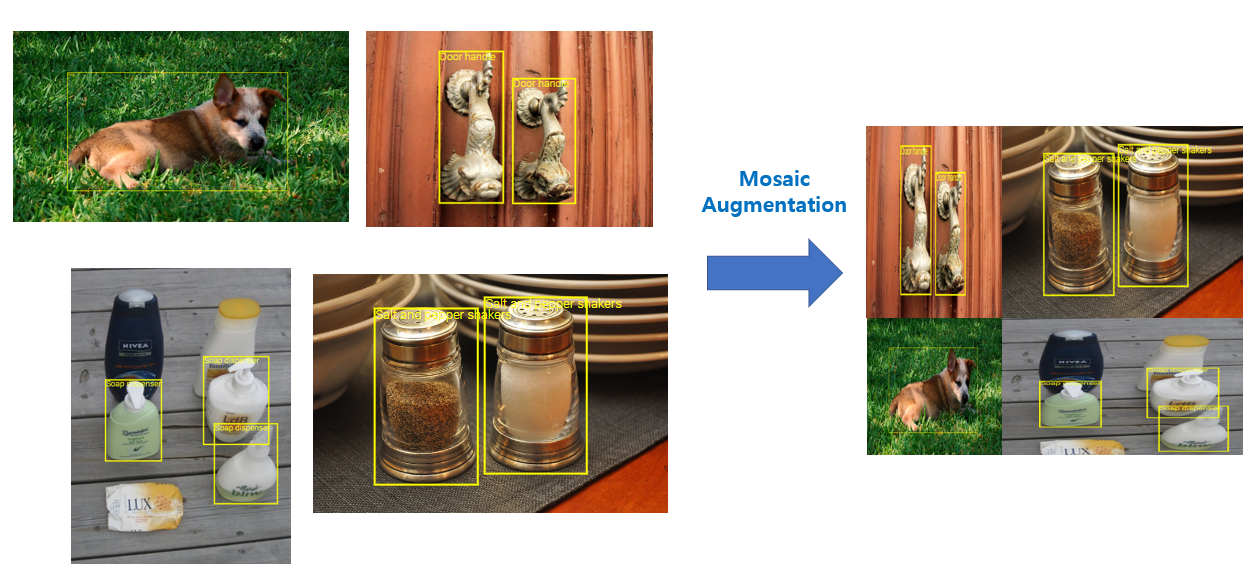High Performance Tensorflow Data Pipeline with State of Art Augmentations build as a wrapper aroung tensorflow datasets api, with low level optimizations.
- Python 3.8
- Tensorflow 2.2
- Tensorflow addons
- Sklearn
- typeguard
Install using:
pip install tensorflow-addons==0.11.2
pip install tensorflow==2.2.0
pip install sklearn
pip install typeguard
- High Performance tf.data pipline
- Core tensorflow support for high performance
- Classification data support
- Bbox data support
- Keypoints data support
- Segmentation data support
- GridMask in core tf2.x
- Mosiac Augmentation in core tf2.x
- CutOut in core tf2.x
- Flexible and easy configuration
- Gin-config support
- Custom numpy function injection.
from pipe import Funnel
from bunch import Bunch
"""
Create a Funnel for the Pipeline!
"""
# Config for Funnel
config = {
"batch_size": 2,
"image_size": [512,512],
"transformations": {
"flip_left_right": None,
"gridmask": None,
"random_rotate":None,
},
"categorical_encoding":"labelencoder"
}
config = Bunch(config)
pipeline = Funnel(data_path="testdata", config=config, datatype="categorical")
pipeline = pipeline.from_dataset(type="train")
# Pipline ready to use, iter over it to use.
# Custom loop example.
for data in pipeline:
image_batch , label_batch = data[0], data[1]
# you can use _loss = loss(label_batch,model.predict(image_batch))
# calculate gradients on loss and optimize the model.
print(image_batch,label_batch) import numpy as np
from tensorpipe.pipe import Funnel
"""
Create a Funnel for the Pipeline!
"""
# Custom numpy code for injection.
def numpy_function(image, label):
"""normalize image"""
image = image / 255.0
return image, label
config = {
"batch_size": 2,
"image_size": [512, 512],
"transformations": {
"flip_left_right": None,
"gridmask": None,
"random_rotate": None,
},
"max_instances_per_image": 100,
"categorical_encoding": "labelencoder",
"numpy_function": numpy_function,
}
funnel = Funnel(data_path="tfrecorddata", config=config, datatype="bbox")
dataset = funnel.from_tfrecords(type="train")
for data in dataset:
print(data[1].shape)from tensorpipe.funnels import funnels
class CustomObjectDetectionLoader(funnels.BboxFunnel):
def __init__(self, *args):
super().__init__(*args)
def encoder(self,args):
# encoder is overriden to give custom anchors to the model as per the need.
image_id, image, bbox, classes = args
# make custom anchors and encode the image and bboxes as per the model need.
return image, custom_anchors, classes
def decoder(self, args):
# override decoder if using custom tf records and decode your custom tfrecord in this method
return decoded_data
funnel = CustomObjectDetectionLoader(data_path="tfrecorddata", config=config, datatype="bbox")
dataset = funnel.from_tfrecords(type="train")- use funnels.create_records script to build tfrecord or build your own tfrecords using your custom script.
- if used the create_records script to build records, we dont need to overide decoder, but if using custom script overriding the decoder function is mandatory.
- If using anchors in the models, please override encoder with custom anchor script.
import tensorflow as tf
from pipe import Funnel
"""
Create a Funnel for the Pipeline!
"""
config = {
"batch_size": 2,
"image_size": [100, 100],
"transformations": {
"flip_left_right": None,
"gridmask": None,
"random_rotate": None,
},
"categorical_encoding": "labelencoder",
}
pipeline = Funnel(data_path="testdata", config=config, datatype="categorical")
# from dataset i.e normal dataset.
pipeline = pipeline.from_dataset(type="train")
# e.g from tfrecords i.e tfrecord dataset.
# pipeline = pipeline.from_tfrecords(type="train") # testdata/train/*.tfrecord
# Create Keras model
model = tf.keras.applications.VGG16(
include_top=True, weights=None,input_shape=(100,100,3),
pooling=None, classes=2, classifier_activation='sigmoid'
)
# compile
model.compile(loss='mse', optimizer='adam')
# pass pipeline as iterable
model.fit(pipeline , batch_size=2,steps_per_epoch=5,verbose=1)- image_size - Output Image Size for the pipeline.
- batch_size - Batch size for the pipeline.
- transformations - Dictionary of transformations to apply with respective keyword arguments.
- categorical_encoding - Encoding for categorical data - ('labelencoder' , 'onehotencoder').
Creates a gridmask on input image with rotation defined on range.
- params:
- ratio - grid to space ratio
- fill - fill value
- rotate - rotation range in degrees
Mixes two randomly sampled images and their respective labels with given alpha.
- params:
- alpha - value for blend function.
Randomly erases rectangular chunk with is sampled randomly on given image.
- params:
- prob - probablity to randomerase on image.
Overlaps a resized randomly sample image on given image with complete overlay on subset portion of image.
- params:
- prob - probablity to CutMix on image.
Creates a mosaic of input 4 images into one single image.
- params:
- prob - Probablity to mosaic.
source (https://www.researchgate.net/publication/340296142/figure/fig1/AS:874996595429376@1585626853032/Comparison-of-our-proposed-Attentive-CutMix-with-Mixup-5-Cutout-1-and-CutMix-3.png)
source (https://storage.googleapis.com/groundai-web-prod/media/users/user_302546/project_404544/images/x1.png)
- v1.0
- Bbox, Keypoints, Custom Py Functions Support.(WIP)
- v1.0-beta
- Classification Support with gridmask and mosaic augmentations.
Kartik Sharma – @linkedIn – kartik4949@gmail.com
Distributed under the Apache 2.0 license. See LICENSE for more information.






